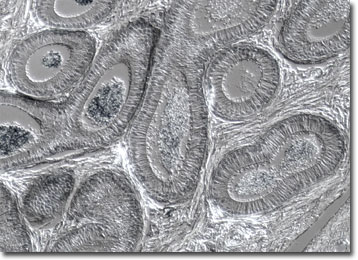Differential Interference Contrast Image Gallery
Cat Testes Stained Thin Section
Cats were first domesticated by the Egyptians about 5,000 years ago and, since that time, their relationship with humans has had its ups and downs. Once worshipped as deities, during the Middle Ages superstitious Europeans often sacrificed cats, believing that they were agents of the devil.

Members of the family Felidae, cats are carnivorous and are highly reputed for their hunting abilities. In fact, their finesse at capturing fish, birds, and rodents played a large part in their domestication and their early sacred status. Also, when cats became unpopular in Europe and their numbers decreased, the flourishing of rat populations that resulted helped lead to the spread of a great number of plagues and epidemics. By the seventeenth century, Europeans began to realize their mistake and cats became accepted household companions once again. Yet, even in modern times, vestiges of their former persecution remain, as is evidenced by the continued association of black cats with Halloween and bad luck.
Domestic cats are prolific reproducers capable of having several litters of kittens in a single year. When females go into heat, they may become ill tempered and nervous, while males seeking a mate act restless, crying loudly and wandering about. A single litter may contain as many as seven kittens, so cat populations could become unmanageable if measures were not taken to curb the number of pregnancies. Previously, selective killing of newborns was the common method of cat population control, but advances in veterinary medicine have since made sterilization the preferred approach.
